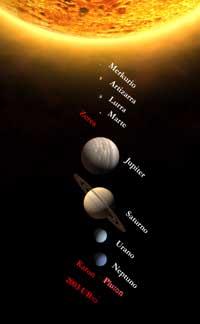Pluto ceases to be a planet
2006/09/10 Rementeria Argote, Nagore - Elhuyar Zientziaren Komunikazioa

Pluto was discovered in 1930 at the Lowell Observatory. In the search for a ninth planet, the calculations indicated the existence of a planet that affected the orbit of Neptune and discovered that distant and diffuse light: Pluto. Then they saw that the calculations were not correct because the mass of Neptune was poorly calculated, but yet there was the new planet.
They saw that the planet was much smaller than the other eight and more than one questioned whether it was a planet. In 1978 they discovered that Pluto had a moon (Charon), which surprised him rather than calm the debate, as they realized that the point they were observing were two structures (Pluto and Karon), so the mass of Pluto was less than they calculated.
As you can see, the debate is not today, it comes from a long time ago. But there was a fact that the issue broke out: as technology progresses, more objects have been discovered in our solar system; gradually they were discovering objects that approached Pluto's measure, until they found one bigger than Pluto: 2003 UB313. The exact data of the discovery was given last year and from then on the salsa on the planets was heated: If Pluto was a planet, also UB313.

That question had to be clarified. And not only that, but clear criteria were needed to classify the objects that could be found in the future. In short, it was necessary to clarify what a planet is and what is not.
Definition of the planet at the end
So what is a planet? According to the definition just given by the IAU in August, a celestial body has to fulfill three characteristics to be a planet: one, orbiting around the Sun; two, with enough mass for its gravity to exceed the forces of rigid bodies, that is, for the form to have a hydrostatic balance (almost circular); and three, the orbit that has been ‘cleaned’.

Pluto does not fulfill the third characteristic, so it is not a planet. They have given it another category: it is a dwarf planet. And there are also dwarf planets Charon (the moon of Pluto), Ceres (the largest asteroid in the asteroid belt between Mars and Jupiter) and UB313 (awaiting a more appropriate name). Apparently, Pluto has not wanted to descend too much of a category, is a dwarf planet not a planet?, and has said that he is the representative of objects beyond Neptune.
However, this representative still does not know it very well, it remains a distant and diffuse light. At the moment, it is in the media where more light does, and probably until 2015. And that is when the New Horizons probe reaches the vicinity of Pluto and will send very close information: then we will know how the dwarf planet Pluton really is.
Published in 7K.




